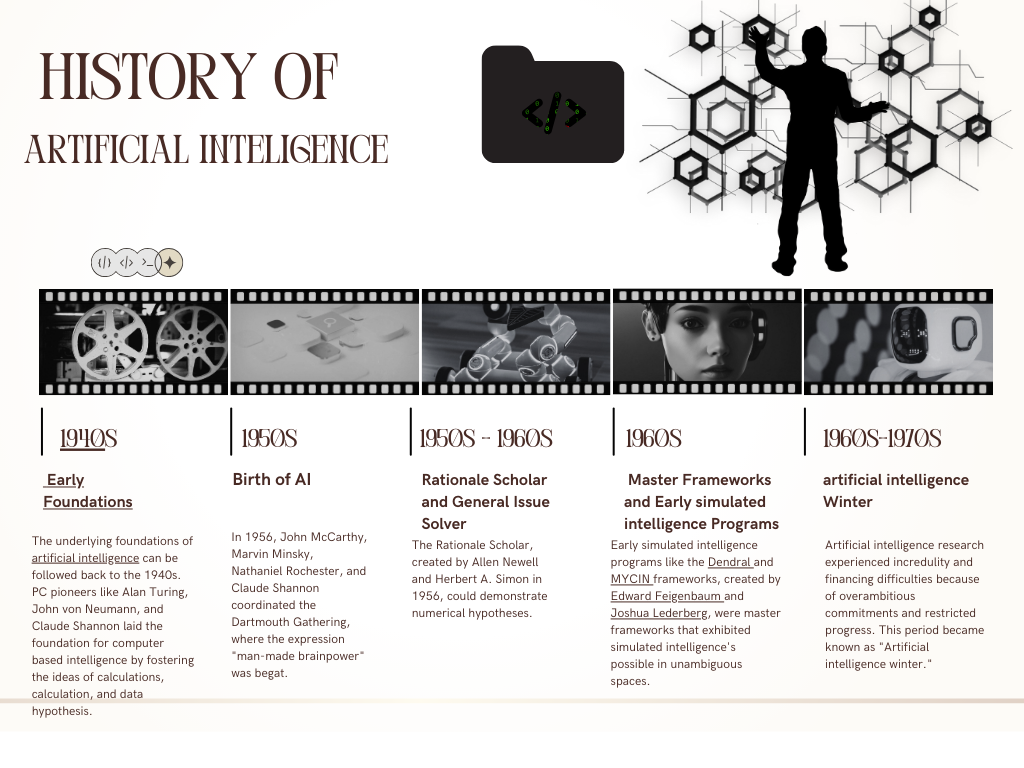The historical backdrop of computerized reasoning (simulated intelligence) is a definite and diverse excursion that traverses a very long while. Here is a more far reaching check out at the critical achievements and improvements throughout the entire existence of computer based intelligence:
- The underlying foundations of artificial intelligence can be followed back to the 1940s. PC pioneers like Alan Turing, John von Neumann, and Claude Shannon laid the foundation for computer based intelligence by fostering the ideas of calculations, calculation, and data hypothesis.
- Turing’s paper “Figuring Hardware and Knowledge” in 1950 presented the possibility of a test (the Turing Test) to decide a machine’s capacity to show human-like knowledge.
1950s – Birth of AI:
- In 1956, John McCarthy, Marvin Minsky, Nathaniel Rochester, and Claude Shannon coordinated the Dartmouth Gathering, where the expression “man-made brainpower” was begat.
- Early simulated intelligence research in this decade zeroed in on emblematic artificial intelligence, utilizing coherent images and rules to address information and tackle issues.
1950s-1960s – Rationale Scholar and General Issue Solver:
- The Rationale Scholar, created by Allen Newell and Herbert A. Simon in 1956, could demonstrate numerical hypotheses.
- The Overall Issue Solver, likewise by Newell and Simon, showed critical thinking abilities.
1960s – Master Frameworks and Early simulated intelligence Programs:
- Early simulated intelligence programs like the Dendral and MYCIN frameworks, created by Edward Feigenbaum and Joshua Lederberg, were master frameworks that exhibited simulated intelligence’s possible in unambiguous spaces.
- ELIZA, made by Joseph Weizenbaum in 1966, was an early chatbot program that reproduced regular language discussion.
1960s-1970s – artificial intelligence Winter:
- Artificial intelligence research experienced incredulity and financing difficulties because of overambitious commitments and restricted progress. This period became known as “Artificial intelligence winter.”
1980s – Master Frameworks and Information Based Systems:
- Master frameworks acquired ubiquity, with MYCIN and Dendral as prominent models. These frameworks were rule-based and could go with choices in unambiguous areas.
- Information based frameworks were utilized in different ventures, including medical care, money, and designing.
1990s – AI and Information Based AI:
- AI, including brain organizations, acquired consideration as a strong man-made intelligence approach.
- Master frameworks kept on being applied in different fields.
1997 – Dark Blue versus Kasparov:
- IBM’s Dark Blue PC crushed world chess champion Garry Kasparov, denoting a huge artificial intelligence achievement in unambiguous undertakings.
2000s – Huge Information and AI Resurgence:
- The accessibility of enormous datasets and expanded figuring power prompted a resurgence in AI research.
- Support Vector Machines, choice trees, and different methods acquired unmistakable quality.
2010s – Profound Learning and Down to earth computer based intelligence Applications:
- Profound learning, particularly profound brain organizations, made surprising progress in picture and discourse acknowledgment, regular language handling, and the sky is the limit from there.
- Organizations like Google, Facebook, and OpenAI made forward leaps in computer based intelligence, prompting functional applications like remote helpers and self-driving vehicles.
2020s – artificial intelligence Combination in Everyday Life:
- Artificial intelligence innovations, for example, chatbots, suggestion frameworks, and independent vehicles, turned out to be progressively coordinated into regular day to day existence.
- Moral and administrative difficulties connected with computer based intelligence, remembering inclination for calculations and information security, collected critical consideration.
The historical backdrop of artificial intelligence is portrayed by patterns of excitement and doubt, yet ongoing forward leaps in AI and profound learning have moved artificial intelligence into another time of pragmatic applications and groundbreaking potential. Artificial intelligence keeps on advancing, molding different parts of society, from medical care and money to diversion, with continuous innovative work in the field.
